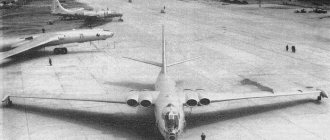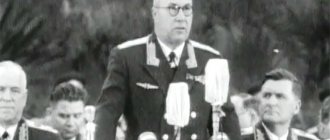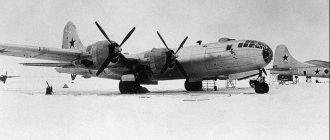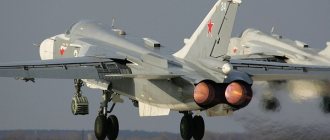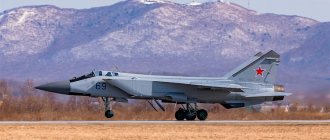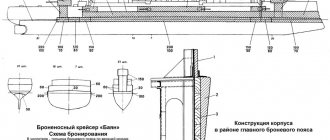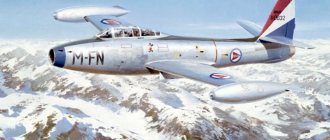The second half of the twentieth century can easily be called the era of strategic bombers. These huge machines, armed with the most deadly weapons that man has ever invented, patrolled at sky-high heights, symbolizing the inevitability of a retaliatory strike. They ensured mutually assured destruction in the event of a nuclear conflict.
After the USSR received nuclear weapons, the question arose about how to deliver them to the territory of a potential enemy. They took two paths: the development of intercontinental ballistic missiles and strategic bomber aircraft, which were armed with nuclear bombs or cruise missiles, began.
Western countries, especially the United States, were significantly superior to the Soviet Union in this area. In 1949, the B-36 was built in America - the first aircraft that can safely be called a strategic bomber. In the same year, the USSR began mass production of the Tu-4, an exact copy of the American B-29 aircraft. But it was more likely a long-range bomber; for a “strategist” this machine is clearly rather weak. All of the above vehicles were turboprops, but soon a new era in bomber aviation begins, and the “strategists” overcome the speed of sound.
At that time there were no anti-aircraft missiles that could reach high-speed aircraft at high altitudes, so increasing the speed of the aircraft seriously increased their combat qualities. However, flying at supersonic speeds presented the designers with a number of complex technical problems.
The USA developed the B-58 and A-5, and the Soviet Union responded by creating the M-50 and Tu-22. These machines can easily be called masterpieces of engineering; they contained all the technical achievements of their time.
The Tu-22 bomber became a landmark aircraft for Soviet military aviation . This aircraft is a real long-liver: it made its first flight in 1958, and its operation ended in Russia, in 1994. The Tu-22 has gone through several modernizations, its latest modifications were significantly different from the machine, which was made under the leadership of the brilliant Russian aircraft designer Andrei Nikolaevich Tupolev.
The history of the creation of a long-range bomber
In 1959 A.N. Tupolev began developing the Tu-22M . The general designer created a machine with a variable geometry wing, which makes it possible to significantly reduce fuel consumption in the main flight modes. The weapon system of the predecessor of the Tu-22 - the Kh-22 , as the main type of weapon, but with the possibility of mounting two more such missiles during combat operations at a shorter range.
Tu-22
The Tu-22MO prototype was first tested in the air at the end of August 1969, and until 1972, nine more pre-production vehicles were produced. But the efficiency of the NK-144-22 engines turned out to be clearly insufficient and the already serial Tu-22M1 was equipped with other power plants - the NK-22 engines, which developed thrust 10% more than the NK-144-22. At this stage the design removed the wing landing gear nacelles, the wingspan became larger and various improvements were introduced.
the Tu-22M2 model went into production ; between 1972 and 1983, 211 such vehicles were produced. At the beginning of 1983, the Tu-22M3 combat units with a modified shape of the air intakes, a reinforced wing structure and an NK-25 power plant. Kh-22 Kh-15P missiles appeared in service ; the aircraft was adapted for low-altitude combat operations and joint work with AWACS aircraft.
Tu-22
FRONT BOMBER AIRCRAFT
Since 1977, the Sukhoi Design Bureau has been working on the Su-24BM (T-6BM) project (major modernization) - a deep modernization of the Su-24. However, sometimes the designation of this project is Su-30 (the first with this name).
At the same time, the vehicle was increased in size (this was especially true for its width, since the bomb bay was supposed to be placed between the engines). The design of the air intakes also changed: they were located under the wing. The car was planned to be equipped with two AL-31F turbofan engines. The composition of its avionics had to change, the range of weapons used should have been expanded, and the characteristics of the anti-aircraft guns had to be improved. The preliminary design of the Su-24BM, completed under the leadership of lead designer V.F. Marov, was completed in 1981. At the same time, a full-scale model of the future aircraft was built. The acceptance certificate for the preliminary design and layout was approved by the Commander-in-Chief of the USSR Air Force, Chief Air Marshal P.S. Kutakhov. Only the signature of I. S. Silaev, Minister of Aviation Industry of the USSR, remained.
Next - a word about the decisive moments of the “biography” of the Su-24BM to aircraft designer O.S. Samoilovich, then working at the Sukhoi Design Bureau:
“This is where M. Simonov intervened. He managed to convince the minister that the Su-24BM is a thing of the past, and a completely new aircraft needs to be made. So, at the insistence of Simonov, the topic of the Su-24BM was closed. When this happened, P. Kutakhov became furious. He came to our company together with M.N. Mishuk. Ivanov was not there; he was delayed somewhere. The Commander-in-Chief was received by Simonov and I. Simonov began to report to Kutakhov himself. He got angry, stood up and said that he had nothing more to do here - he approved the act of protecting the preliminary design and layout of the Su-24BM, and MAP is obliged to start creating this aircraft, and not offer something new. Simonov ran to the Kremlin (government communications - S.D.) to ask for help from Silaev. The minister replied that he would arrive immediately and asked Kutakhov to stay. The conflict was settled, but the Su-24BM aircraft was never built..."
Initial version of Su-24BM
Thus, at that moment, the management of the Sukhoi Design Bureau made a “bet” on a completely new project - the T-60, which began to “squeeze” the Su-24BM. In addition, the military made a number of proposals to further expand the capabilities of deep modernization. Therefore, in 1981, work began with renewed vigor: supporters of the modernization of the Su-24 replaced the variable-sweep wing with a fixed one, the single-fin tail became double-finned, and the composition of the avionics also changed significantly. In 1983, a full-size mock-up of the Su-24BM2 (T-6BM2) aircraft was built, and the preliminary design was successfully defended (1982), but the management of the Sukhoi Design Bureau and MAP decided to “promote” the T-60 project...
Improved version of Su-24BM
Since 1985, OKB im. P. O. Sukhoi began work on further modernization of the Su-24 aircraft, as a result of which a modification of the Su-24MM (small modernization) was created. One of its authors was V. R. Kovtun.
Su-24MM
The new version of the Su-24 was supposed to be equipped with new, more economical AL-31F turbofan engines, which, in combination with the MVM increased by 2 tons, should have led to a significant increase in the vehicle’s flight range. A characteristic feature of the vehicle’s appearance is the presence of a third, additional air intake located on the top of the fuselage (it was necessary for new engines). At the same time, the composition of avionics and the range of weapons used have changed slightly.
Its second option, actively “promoted” by representatives of the Air Force, involved the use of conformal tanks.
Subsequently, work on the project was interrupted because... The Customer was not particularly interested in it, and the OKB management preferred to develop the Su-27IB program (the future Su-34).
According to the recollections of veterans of the Sukhoi Design Bureau, if it were not for the cessation of work on improved versions of the Su-24, the Soviet Air Force would have had 150-200 new aircraft, significantly superior in their capabilities to the Su-24M.
Design of the Tu-22 bomber
The aerodynamic design of the Tu-22 is a glider with a low wing of variable geometry and a powerful vertical tail with a rotary stabilizer. The wing with a high degree of mechanization is equipped with three-section slats, the flaps are located on the center section and consoles, spoilers with three sections work as ailerons, controlling the machine in roll.
Tu-22
A hydraulic system with an electric propulsion system rotates the wing to fixed positions from 200 to 600 every 10 degrees and to an extreme rotation angle of 650. The negative influence of air intakes with air tunnels and the center section on the aerodynamics of the vertical tail at high angles of attack was successfully compensated by installing a large forklift.
The cockpit of a Tu 22M3 aircraft
The crew cabin of the Tu-22M3 is much more comfortable and ergonomic than that of its predecessor Tu-22 . The seat layout remains the same - the commander and right pilot are in front, the navigator and operator are behind. Each crew member is placed in a KT-1M ejection seat; ejection is carried out upward, facing against the flow.
Tu-22 cockpit
The glass area of the canopy has been reduced somewhat so that glare does not interfere with monitoring instrument readings. A comprehensive air conditioning system maintains comfortable conditions inside the cabin for the performance of all pilots.
The aircraft's landing gear is tricycle, the front strut is controlled, the main struts consist of three-pair brake wheel bogies. In flight, the struts are retracted inside the aircraft body, the main struts are perpendicular to the flight, the bow strut is retracted backwards along the flight.
A new radar station and an improved sighting system were installed on the Tu-22M3 New brushless generators in the power supply system have received electronic control. Lead batteries were replaced with nickel-cadmium batteries, which improved the quality of power supply and the reliability of electronics.
Tu-22 layout diagram
Performance characteristics
- Aircraft length – 42.46 m
- Height – 11.05 m
- Fully extended wing span – 34.3 m
- Folded wing span – 23.4 m
- Bomb bay: width – 1.8 m; length – 7 m
- Maximum take-off weight – 124 t
- Combat load – 21 t
- Fuel capacity - 53.5 tons
- Powerplant – 2 X NK-25 turbofan engines
- Maximum thrust in afterburner – 25,000 kgf
- Maximum speed at altitude – 2300 km/h
- Maximum ground speed – 1050 km/h
- Cruising speed – 900 km/h
- Take-off distance – 2100 m
- Landing distance length – 1300 m
- Take-off speed – 370 km/h
- Kh-22 missiles or 21 tons of bombs, half of which are placed on underwing pylons, the rest inside the bomb bay. Instead of bombs, a rotating installation for six X-15 . At the rear end of the fuselage, under the keel, there is a remote-controlled twin GSh-23
Tu-22
oPNEYRKHPPNBYUMKHE SVEAMN-RPEMKHPPNBNVMNTsN YYULNKERYU RS-22sMYUVYUKNYAE B 1961 Ts. TsND YAOSYAR OPKHYARSOKHKH Y GYUBNDYAYHL HYAOSHRYUMKHL OEPBNTSN, OEPEDEKYUMMNTSN HG rs-22p, SVEAMNTsN YAYULNKERYU ╧ 601. gyu YUAKHMNI YNMRPNKHPSELN CN (NASVYUELNTSN) OHKNRYU PYUGLEYARHKH YYUAHMS KERVKHYU-KHMYARPSYRNPYU I YUYUPYUREPMSHL BSHYARSOYUCHIHL TNMYUPEL. YaMKKH YNPLNBSC YARPEKINBSCH SYARYUMNBYS, OPEREPOEK KHGLEMEMKH YANYARYUB NANPSDNBYUMKH. MU YURYUOSKERKHPSELNE YPEYAKN KHMYARPSYRNPYU, BSHAPYYASHBYUBIETSNYA B YUBYUPKHIMNI YAHRSYUZHHH, YUY X MU ANEBSHU LYUHMYUU, BMHG, SYARYUMNBHKH ANKEE LNYMSHI YARPEKCHYKHI LEUUMKHG L.
YaYULNKER OPNUNDHK GYUBNDYAYKHE HYAOSHRYUMKH I 4 MNAP 1961-TSN OH 28 YOOPEK 1963 Ts. b KhChME NM B REVEMHE MEDEKH MUUNDHKYA MU YAOEZHYUKEMSHU HYAOSHRYUMKHU B mkhh bbya. I 23 KhChK MYUVYUKYA SCHRYUO TSNYASDYUPYARBEMMSHU HYAOSHRYUMKHI MU DPSTSNI LYUKHME, ╧ 602. mN 27 KhChK ONKERSH BYAU RS-22 GUOPERHKH HG-GYU YURYUYARPNTSH NDMNTsN HG RS-2 2p dYUKEMEY YUBHYUZHHH (OEPBSCH LYUHMS BNEMMSHE ONREPKKH 18 YUBTSSYARYU 1962 Ts. B khkh). YaOSYAR 19 DMEI HYAOSHRYUMKH OPNDNKFHKHYAE X GYUBEPHKHYAE 28 ЪМБУПЪ 1965 Ts. I PAINLEMDUZHHEI N OPHMIRKHH SVEAMNI LNDHTHYUZHHH MY BNNPSFEMKHE. th SHRNLS BPELEMKH YAEPKHIMSHE rs-22s SFE ONYARSOYUKH B bbya. VSRE ONGFE, MN B RNL FE 1965 Ts., MU SVEAMSHE LYUKHMSH YARYUKH SYARYUMYUBKHBYURE NANPSDNBYUMKHE DK DNGUOPYUBYKH RNOCKHBNL B ONKERE H ANKEE LNYMSHE rpd pd-7l2. RUYHE YAYULNKERSH ONKSVHKH NANGMYUVEMHE RS-22SD
.
sVEAMSHI BYUPKHYUMR "bHKYU" DNBNKEMN DNATSN YAKSFHK B VYUYARU bbya KH LNPYAYNI YUBHYUZHHH AEG YASYYARBEMMSHU MEONKYUDNY. oEPBYU YURYUYARPNTY SVEAMNI LYUHMSH OPNHGNYU 23 LYUPRY 1968 Ts. oPH BSHONKMEMHH OPEDONYYUDNVMNTSN LYUMEBPU MENFKHDUMMN NRBYUKHKYUYAE BYA UBNYARNBU VYUARE. oNTsHAKH KERVKHYKH a. VSFYNB, m. ULSHPEB KH LRSPLUM k. BONYAKEDYARBKHH BSHYAMHKNYAE, VRN OPHVKHMNI RPYUTSEDKHH YARYUKKH SYARYUKNYARMSHE RPEYKHMSH B YNMYARPSYZHKH OKYUMEPYU, BNGMKHYKHE B PEGSKERYURE KHMREMYAKHBMNI SHYYAOXYURYUZHKH. MELEDKEMMN BEYAE OYUPY RS-22s ONDBEPTSYA RYYUREKEMNI OPNBEPE. YaYULNKERSH, MU YNRNPSHU BSHUBHKKH NOYUMSHE DETNPLYUZHKH, ONKKH B PELNMR. BYAETSN GYUBND ╧ 22 ONYARPNHK 46 SVEAMSHU LYUHM, BYKCHVYU DBE NOSHRMSHE, OEPEDEKUMMSHE HG RS-22p.
rs-22s ONYARPNEM OH YUSCHPNDHMYULKHVEYAYNI YAUELE YABNANDMNMEYASYETSN MKHGYNOKYUMYU YAN YARPEKNBKHDMSHL YPSHKNL (55╟ OH OEPEDMEI YPNLYE). yPSHKN DBSUKNMFEPNMMNE YAYAYANMMNI YNMYARPSYZHHH. LEUUMHGYUZHK YPSHKYU YANYARNHR XG BMSRPEMMKHU DBSUYEKEBSHU GYUPSHKYNB X BMEMKHU SCHEPNMNB-GUYPSHKYNB. tsNPKHGNMRYUKEMNE NOEPEMKHE YARPEKNBKHDMNE (58╟41′ OH OPEDMEI YPNLYE), ZHEKEMNONBNPNRMNE. tCHGEKЪF RHOYU ONKSLNMNYNYI I TSKYUDYNI PUANRYUCHYEI NAHBYNI. yuYAYAH RP╦UNONPMNE I AM MYANBNI YARNIYNI. REKEFYKH NYAMNBMSHU YARNEY YUYAYAH SAKHPYUCHRYA B TsNMDNKSH MU YPSHKE. YAKHKNBYU SYARYUMNBYU YANYARNHR HG DBSU rpd pd-7l (ONGFE pd-7l2). dBKHTSUREKH SYARYUMNBKEMSH B UBNYARNBNI VYUYARKH B LNRNTsNMDNKYUU MYUD TCHGEKFEL. dKЪ BGK╦RYU LNTsSR OPHLEMЪREYA ONPNUNBSHE SYAYNPKHREKH, YPEOYKHEYAY Y ZHEMRPNOKYUMS. dK YANYYYYYYEMH OPNAETSU OPH ONYUDYE HYAONKEGSERYA DBSUYSONKEMSHI RNPLNGMNI OYUPYUCHR. schYHOYUF PUYAONKYUTSYUKYA B TSEPLERKHVMNI YUAHME B MNYANBNI VYUYARKH TCHGEKKFYU. yYUAHMYU K╦RVKHYU-KHMYARPSYRNPYU YAN BRNPSHL SOPYUBKEMHEL PUGLEYYUKYUYAE MY LEYARE PUDHARYU H HLEKYU BSHYARSOYUCHIKHI BBEPU TNMYUPE. yYURYUOSKERMNE YPEYAKN KHMYARPSYRNPYU ONKSVHKN ANKEE LNYMSHI YARPEKCHYKHI LEUUMKHGL. yNPLNBYU OSEVMYU SYARYUMNBYU NRYASRYARBNBUKYU. MU LNDKHTHYUZHKH RS-22SD SYARYUMNBKHBYUKNYAE NANPSDNBYUMKH DNGYUOPYUBYKH RNOXBNL B BNGDSUE RHOYU "KYUMTS-YNMSYA".
bYaETsN KHCTsNRNBKEMN 46 YYuLNK╦RNB RS-22s.
ONYARYUBKKYA MU SHYYAONPR B xPYUY X kHBHCH. ONYAKE PYUYAYUYAYAP MEYAINKEIN YYULNK╦RNB DNYARYUKNYAE SYYYUKHME. lNDHTHYUZHHH :
| RS-22s | SWEAMSHI ANLAYUPDHPNBIKHY. BSHOSYAYUKYA I 1963 TsNDYU. xGTSNRNBKEMN 46 YALNK╦RNB. |
| RS-22sd | DUKEMHI. nRKHVYUKYA MYUKHVHEL YAKHYARELSH DNGYUOPYUBYKH RNOKHBNL B ONK╦RE H DBKHTSUREKLH pd-7l2. |
| cru: |
| lNDHTHYUZHH | RS-22s |
| pYUGLYU YPSHKEEB, L | 23.65 |
| dKKhMYu, L | 41.60 |
| bSHYANRYU, L | 10.13 |
| OKNYYUDE YPSHKYU, L2 | 162.25 |
| I love it, JC | |
| OSYARNTSN YYULNKERYU | 43580 |
| MNPLYUKEMYU BGKERMYU | 69000 |
| LYUYAHLYUKEMYU BGKERMYU | 85000 |
| RNOKHBU | 40800 |
| RHO DBKHTSUREK | 2 U rpd bd-7l |
| rtsyu, ytsya | |
| BGKERMYU | 2 U 10500 |
| MU TNPYUFE | 2 U 16000 |
| LYUYAKHLYUKEMYU YAYNPNYARE, YL/V | 1387 |
| yPEIYEPYAYU YAYNPNYARE, YL/V | 850 |
| oEPETSNMNVMYU DUKEMNYARE, YL | 7200 |
| oPUYRHVEYAYU DUKEMNYARE, YL | 5130 |
| aNEBNI PYUDKHSYA DEIYARBKH, YL | 3150 |
| oPUYIRKHVEYAYKHI ONRNNKNY, L | 13250 |
| ShYKHOYUF, VEK | 7 |
| bottom. KhMTNPLYUZHKH: |
| tNRNCPYUTHH: | oEPBSHI NOSHRMSHI RS-22s |
| YaEPKHIMSHI RS-22s | |
| RS-22s MU boo | |
| RS-22 | |
| RS-22p | |
| ONYUDYU RS-22SD | |
| ONDTSNRNBYU Y BGKERS RS-22SD | |
| ONDTSNRNBYU Y BGKERS RS-22SD |
bYUPHYUMRSH NYPYYAYH:
| RS-22sd 121-1 TsB. RAYUO 15-NI TsBRAYUD ╘ ChPKHI REOYASPYUEB |
| RS-22SD bbya xPYUYU |
| YaOHYANY HYARNVMKHYNB: |
| yuBHYYNKKEIZHH. mKHYNKYUYYSANBHV. ANLAYUPKHPNBIKHY RS-22 YUBKHYUZHKH bPEL. bHYRNP yNMYARYUMRKHMNB, bYUKEPKHI pNLUMEMYN, YuMDPEI UYUSYARNB. yaBEPUGBSINBNI DNATSNFHREKE yuBKHYUZHKH YNYALNMYUBRKHYU. bKYUDHLHP pHCLYUMR. KHYARNPKH YANGDYUMKH PUGBHRKH YAELEEYARBU YYULNKERNB RS-22 yPSHKE pNDHMSH. mKHYNKYUYYSANBHV. rPSDMSHI BGKER RS-22 yuPLUDYU. mKHYNKYUYYSANBHV. YaBEPUGBSINBNI ANLAYUPDHPNBYKHY RS-22 bbya PNYAHH. KhYARNPKHЪ RS-22 pNLYUM yuYARYUNB. PSYAYAYU YAHKYU. DYUKEMKHI ANLAYUPKHPNBIKHYH PUYERNMNYAEZH RS-22 bKYUDKHLHP pKhTsLYUMR. OND GMYUYULH "yumr" X "rs" nyun "rSONKEB": nR yumr-1 DN rs-334 Altair. Jefim Gordon, Wladimir Rigmant. Tu-22/M/ Naddzwiekowe bombowce Rosji Aerofax. Jefim Gordon, Vladimir Rigmant. Tupolev Tu-22 'Blinder', Tu-22M 'Backfire' |
sTSNKNY MEAYU. 2004
Interesting Facts
- During the Cold War, aircraft carriers of NATO countries were most afraid of Tu-22 ; it was not for nothing that they were nicknamed “aircraft carrier killers.”
- During the hostilities in Afghanistan, Tu-22M3s were used to a limited extent at the very end of the war during the withdrawal of troops.
- On the territory of Chechnya, the Tu-22M3 participated in individual operations to more accurately guide attack aircraft to the target using OSAB.
Tu-22
- In the Georgian-Ossetian conflict of 2008, Tu-22M3 destroyed manpower and bombed warehouses and airfields located in the Kodori Gorge.
- After the Tu-22M3 , the command decided not to use these aircraft anymore.
- In November 2015, fourteen Tu-22M3 took part in the combat operations of the Russian Aerospace Forces in Syrian airspace.
- The Tu-22M3 took part in the filming of the film “Peculiarities of the National Hunt”, and in the film “All the Fears of the World” there is a plot of the attack of this aircraft on an aircraft carrier.
Tu-22
SPECIAL PURPOSE AIRCRAFT
From among the special aircraft during the Soviet era, an improved version of the Il-78M refueling aircraft was developed (first flight on March 7, 1987), whose maximum capacity increased by 20 tons, and its conversion into a transport aircraft became impossible. At the same time, the transmission range of 60 tons of fuel increased by an average of 800 km compared to the original version, and 35 tons by 1,500 km. It is worth noting one little-known feature of the Il-78/78M aircraft: they can provide refueling for up to four aircraft simultaneously and on the ground.
Il-78M
In addition, on January 9, 1984, work began on the A-50M aircraft, which was to be equipped with a modified Shmel-2 radio complex, which had expanded combat capabilities, as well as new RTR equipment. The aircraft was also supposed to be equipped with D-90 engines (later designated PS-90). Its construction began at the aircraft plant in Tashkent in 1987, and flight tests were supposed to begin in 1989. By 2000, it was planned to deliver about 30 vehicles of this version.
To test the new complex, a flying laboratory “2A” has already been created on the basis of the Tu-126 aircraft, which began flying in March 1987. However, in October 1990, by a Decree of the Council of Ministers of the USSR, work on the creation of the aircraft was stopped.


